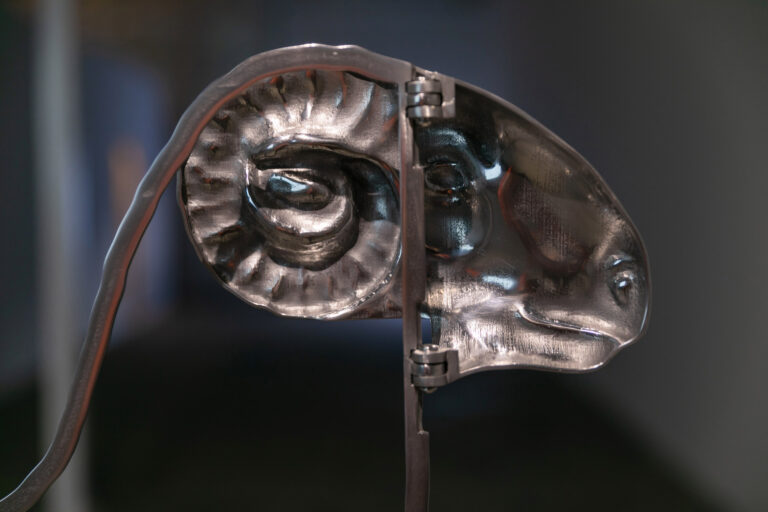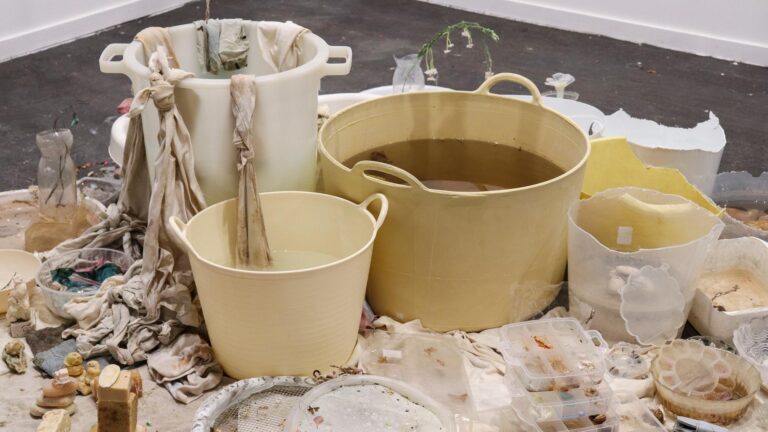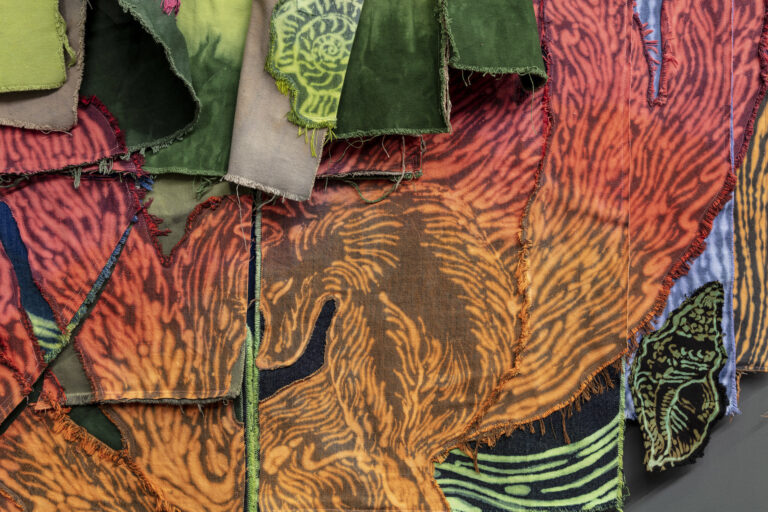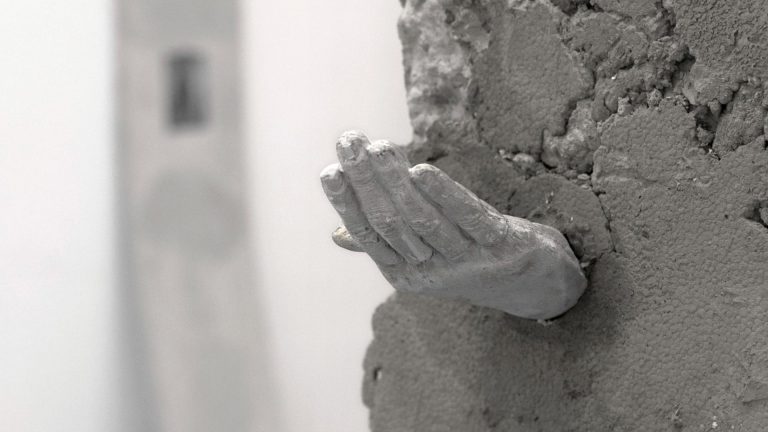The name of the exhibition speaks to a multitude of senses contained in its meaning, carefully assembled from two words – shape and shift, neither entirely linked nor completely apart. As one word, it is used mostly in fantasy writing or in modern pop-culture content, to name a being capable of changing forms or identity at will. What the exhibition explores is a cultivation of connections between social structures and belief systems, through playfulness, harnessing the importance of transformation and movement as tools in the process.
Navigating through the space, we encounter a number of pieces by Marko Obradović, which are paired with a video installation, screening the new film Motonation by Jelena Visković. The scattered pieces orbit around the gallery as satellites of themselves, as there is not a piece that is central or secondary, and they strive to achieve an aligned system, avoiding any nods to a hierarchical placement. In this structural arrangement they become entities sparking a circular narrative of support, and an environment to explore the systems they refer to – of belief, borders, identity and spirituality. We see them in the space as both sentient and inanimate objects, infused with a sense of agency to fulfil their roles of message carriers. Of course, this thought sparks the question of the social accountability that should be handed to an artwork, which does not hesitate away of the artists’ intentions. There is a lot to be traced in their shared practice relating to a desire to express the shifts of power in various social apparatuses in rebellious ways.
Marko Obradović features new paintings on wooden panels cut into specific shapes, some distinguishable and some formed through merging and overlapping of the clear symbols. Throughout his work, Marko has frequently used a combination of depicting these with contemporary pop-culture references from film and music, researching mostly how performativity today is conveyed, and blurring the line between real life and stepping into a character. The protagonists of his recent paintings serve as vulnerable vessels that adopt ideas of identity and spirituality, and oftentimes magical thinking. Sometimes they open a space for identity searching by showing ghoulish figures in frozen states of distress, and other times they craft stories and shape belief systems that rely on existing mythologies in the Balkan region, or ritualistic and communal practices.
In these new pieces, we can see a glimpse of the same intentions, but this time they are characterised through the shapes. The spiral in Heaven’s rot (star) is merged with a star and reminds of an ancient object of worship, like a contemporary cave drawing, referencing the primeval. In Orgone Sanctuary, the object of the chamber points to pseudo medicine and theories of orgone energy by Wilhelm Reich, controversial, but once popular because of its “healing” powers. The search for self-efficacy that the chamber shows is very much still relevant, especially in the rise of the mindfulness and wellness culture in the last decade, popularised by the notion of self-care and the deepened discovery and connection with one self. Despite its bad reputation, the idea may be traced and found in this selection of works in its pure form. They reflect upon it in their own gauzy nature, in a way fighting the contemporary and capitalistic mentality, and stripping it back with mysticism. Through the prism of spiritual thought, the spheres and the vortexes are gentle reminders of one’s inner worlds. A blend of mysterious representations of the world we built, they show people’s desires and their innate need to contextualise and shape their lives.
We tag along to the story of a lone biker trying to expand beyond the boundaries of his own community with the help of a hacked city-motorbike, and step into the realm of his true desires and dreams. In Motonation, movement choreography is used as an instrument that connects the chapters of the story and creates a safe space for rethinking of complex topics. It puts into question the known variables of freedom and body-politics that are continually bound to transform and expand their limits within their immediate surroundings and the timeframe they are considered in. Shifts in time constantly influence how we perceive and deal with freedom that is either newfound or eradicated, when established norms are dismantled. In this respect, we are free to read into the characters presented in the film, using movement as a tool for transformation and consolation as they all shift from one state of identity to another, changing their matter. In my view, in this imaginative narrative, the protagonists are seen not entirely as humans adopting a chair pose, and the motorbike turned evil not as an inanimate object, but as beings assuming an ability to change form depending on their ultimate choices. These may or may not be choices that they are entirely free to make, but what they are left to play with, in this constructed future, and these are the actions the film leaves us to ponder on.
As we have seen in Jelena Visković’s previous works, the focus is on their capability to draw connections between systems of power, systems for communication and knowledge sharing, ideas of hierarchy, all demonstrated and highlighted with the help of technology and a vision of another, upgraded world. The score and the soundtrack of the film sound like echoing mantras, guiding all of those present through the next phase. Just as Her Sanctuary says in the film, leading the community in a shared practice, we will chew through our shared thoughts and digest them, creating a new logic.
–Vanja Žunić






















